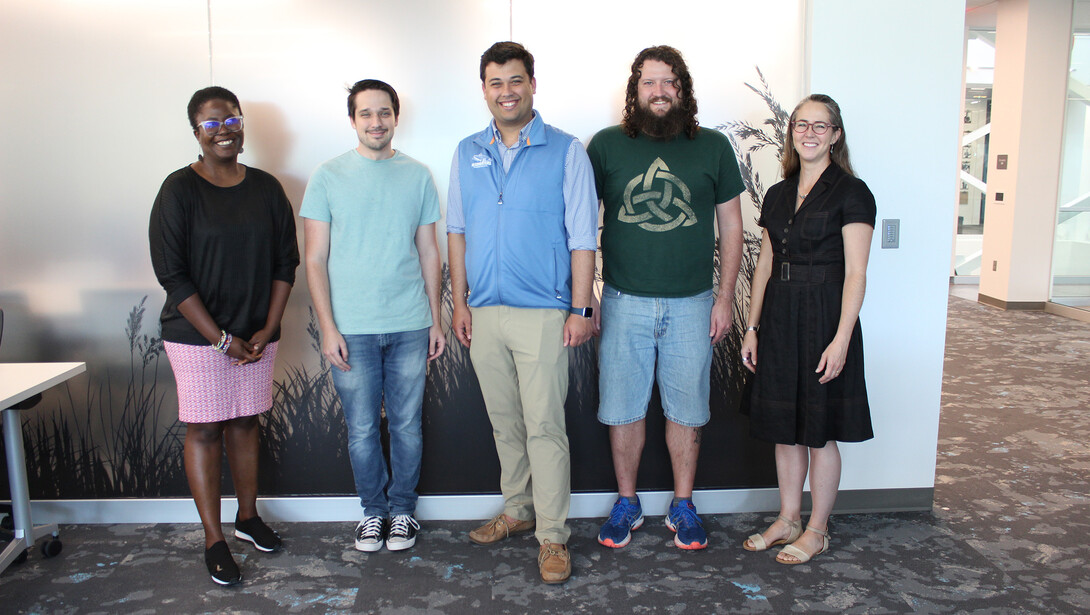
For a quartet of graduate students, the University of Nebraska–Lincoln’s Digital Humanities Fellowship has been challenging, collaborative, expansive, invigorating and transformative experience.
Nebraska’s Ethan Jensen (geography), Patrick Hoehne (history), Olufunke Ogundimu (English), and Kevin Pflager, a masters student in geography, all agree that the collaborative environment of the program was essential to accelerate the development of their projects.
“The fellowship gave me the opportunity to learn so much from Dr. Heitman and my fellows in this program. We all lifted each other up,” Pflager said. “I have been personally and professionally transformed by the experience.”
Offered through the Center for Digital Research in the Humanities and University Libraries, the program gave the students the time, space and access to technology in the Dinsdale Family Learning Commons where they met regularly with Carrie Heitman, director of the summer fellowship. Heitman ran various workshops, mentored the students, and gave short lectures on topics related to the national and international digital humanities landscape, positioning their work in the academy, funding opportunities and grant writing. Heitman also arranged a series of chats with digital humanities practitioners at Nebraska, libraries faculty and staff to speak with the fellows as a group or one-on-one.
“It has been a tremendous honor to work with these brilliant students who are pushing the field of Digital Humanities and their respective disciplines forward,” Heitman said. “I have easily learned as much from them as they have from me.”
Ethan Jensen’s project uses digital immersive simulation to re-create downtown Hallam, Nebraska, as it existed prior to the destructive 2004 tornado. His research area is the process of creating the simulation and refining it. Jensen hopes to digitally rebuild places in the history of Nebraska that suffered de-population or overpopulation or were merged within another community, like the bedroom communities in Omaha and Lincoln.
“We all come with a different perspective and the other fellows and staff have challenged some of my assumptions, pushing me further in my research,” Jensen said.
Patrick Hoehne’s project uses machine learning to expose and explore bias in Civil War-era newspapers, and has benefited from the use of the supercomputer provided by the Holland Computing Center. He has uploaded full-text files of hundreds of thousands of newspaper articles from both the Richmond Daily Dispatch and The New York Times and runs a code to train the model going through the massive text file. He has run 100,000 training steps with the goal to reach a million.
“The output gets tighter the more I train the model, and I hope to make an engaging website where users can put in any prompt text, like abstract words such as heroism, tragedy, monster, and see the different results from the northern paper versus the southern paper,” Hoehne said.
Hoehne hopes to deploy the website by the end of the summer.
Olufunke Ogundimu, plans to build “riot | émeute | randalieren,” a centralized digital repository of documents and photographs of physical African arts looted from francophone, anglophone, arabophone and lusophone African countries. In addition, the web hub will have sections where users can contribute to the provenance of the items and share agitations for the repatriation of these materials to their rightful owners.
Ogundimu’s focus during the fellowship has been on building a prototype around the Benin Expedition of 1897. She has been able to track down and add nearly 2,500 items into her repository from various museum websites in Germany and the British Museum. That work just scratches the surface.
“The estimate is that there are 10,000 items from this expedition located in multiple institutions around the world,” Ogundimu said.
Ogundimu was inspired to begin this project after taking a class with Heitman and is committed to the repository and website as a long-term project.
“I hope this project will lead to the return of materials because removing these items from their culture changed their identity, hurt their national pride, and revised their history,” Ogundimu said.
Pflager was inspired to delve into the historic roots of land consolidation after taking a course with Heitman, too. He has gathered the data from the early 20th century of farm consolidation in Lancaster County with the goal of being able to show the early issues that were the catalyst of farm consolidation now destroying farming communities and rural America.
With his background is in economics and human geography, Pflager has been hand digitizing the plat maps of 167 parcels of land and farms himself. His goal is to create a website, connecting individual farms to articles in newspapers held in the Nebraska Newspaper project and further evidence on why the farm may have been sold.
“This project brings all my research interests together: cartography, economics, geography and examining systemic inequality in the rise of wealthy landowners and speculators buying up the land and creating tenant farmers,” Pflager said.
In the latter six weeks of the fellowship, the students are pursuing their project goals independently, supported by weekly mentoring sessions with Heitman. In the fall, they will share aspects of their learning experience and project results at the first Digital Humanities Afternoons forum event.







